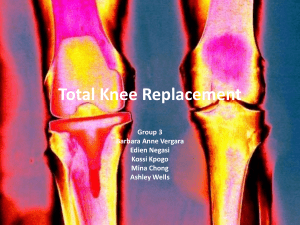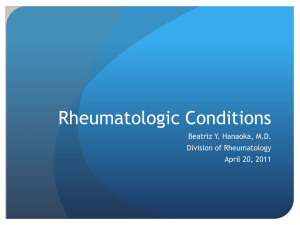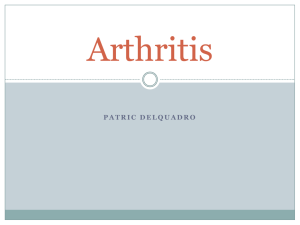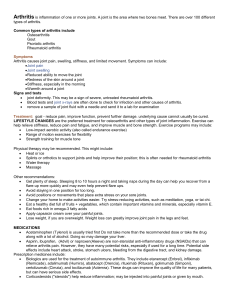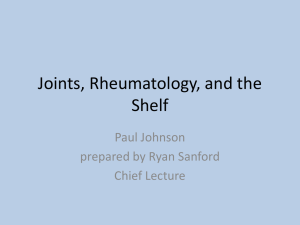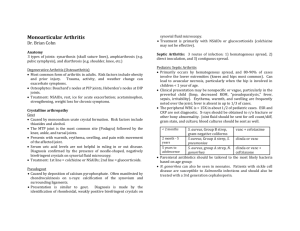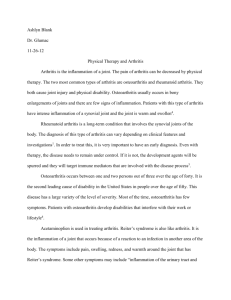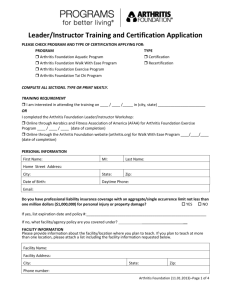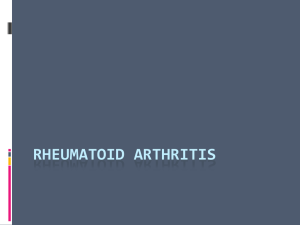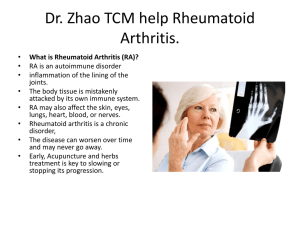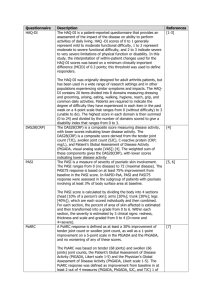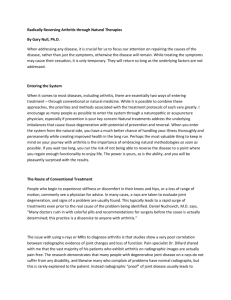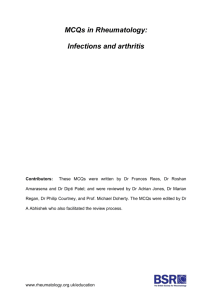ARTHRITIS AND THE EYE
advertisement
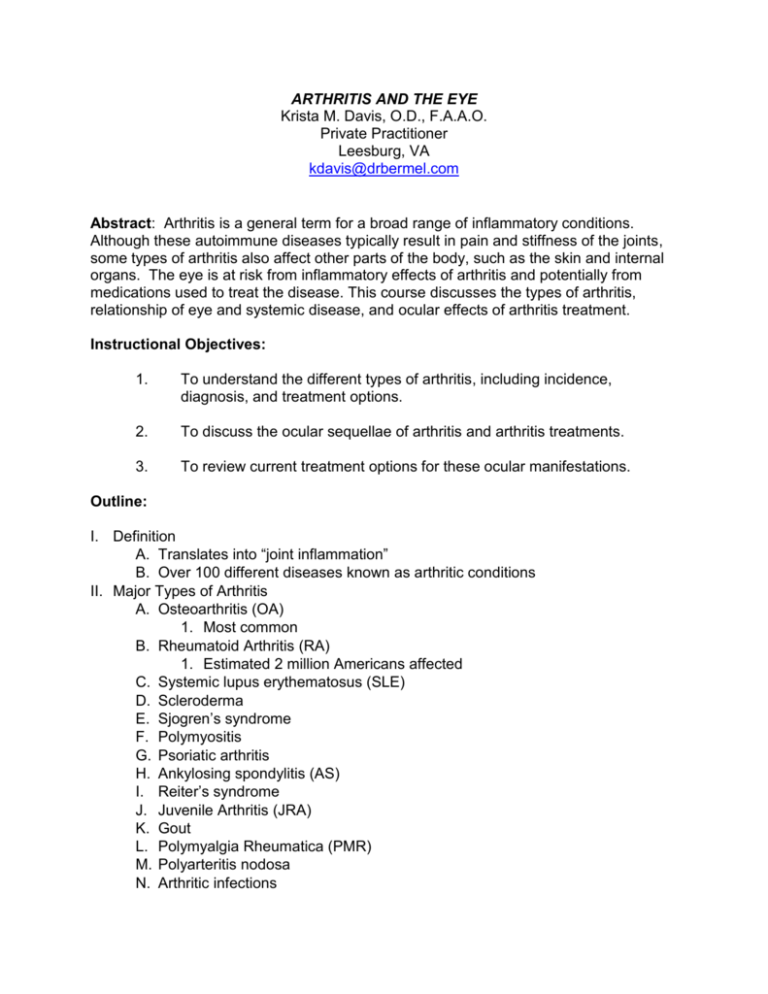
ARTHRITIS AND THE EYE Krista M. Davis, O.D., F.A.A.O. Private Practitioner Leesburg, VA kdavis@drbermel.com Abstract: Arthritis is a general term for a broad range of inflammatory conditions. Although these autoimmune diseases typically result in pain and stiffness of the joints, some types of arthritis also affect other parts of the body, such as the skin and internal organs. The eye is at risk from inflammatory effects of arthritis and potentially from medications used to treat the disease. This course discusses the types of arthritis, relationship of eye and systemic disease, and ocular effects of arthritis treatment. Instructional Objectives: 1. To understand the different types of arthritis, including incidence, diagnosis, and treatment options. 2. To discuss the ocular sequellae of arthritis and arthritis treatments. 3. To review current treatment options for these ocular manifestations. Outline: I. Definition A. Translates into “joint inflammation” B. Over 100 different diseases known as arthritic conditions II. Major Types of Arthritis A. Osteoarthritis (OA) 1. Most common B. Rheumatoid Arthritis (RA) 1. Estimated 2 million Americans affected C. Systemic lupus erythematosus (SLE) D. Scleroderma E. Sjogren’s syndrome F. Polymyositis G. Psoriatic arthritis H. Ankylosing spondylitis (AS) I. Reiter’s syndrome J. Juvenile Arthritis (JRA) K. Gout L. Polymyalgia Rheumatica (PMR) M. Polyarteritis nodosa N. Arthritic infections III. Related musculoskeletal conditions A. Fibromyalgia B. Osteoporosis IV. Prevalence and Incidence A. Nearly 1 in 3 adults B. Women more than men V. Causes A. Likely many 1. Trauma 2. Lack of physical activity 3. Excessive weight 4. Joint defect 5. Aging 6. Genetic defects 7. Abnormal immune system 8. Environmental factors 9. Infectious agents B. Most are unknown C. Recent theories 1. Red meat 2. Silica VI. Risk Factors VII. Pathophysiology A. Chronic inflammation B. Hypertrophied synovial lining C. Role of Interleukin-1 VIII. Diagnostic Tests A. Radiologic Studies B. Tissue Biopsies C. Laboratory tests 1. ANA 2. Rheumatoid factor 3. ESR 4. C Reactive Protein 5. Anti-CCP Antibodies 6. Anti-DNA Antibodies 7. Serum complement levels IX. Management Goals A. Control joint damage B. Prevent loss of function C. Decrease pain X. Treatment Options A. Cold/ Heat B. Medications C. Diet D. Exercise 1. TaiChi for chronic pain E. Physical Therapy F. Occupational Therapy G. Surgery H. Alternative treatments 1. Psychological control of pain XI. History of Treatment A. 1820: Salicylate is isolated from willow bark B. 1860: Duchenne uses electric current C. 1897: NSAIDs D. 1929: Gold salts are used to relieve pain of RA E. 2004: Major NSAIDs pulled off market for increasing risk of heart attack XII. Types of Medications A. Analgesics B. NSAIDs C. Biologic Response Modifiers D. Disease Modifying Antirheumatic Drugs E. Corticosteroids F. Fibromyalgia medications G. Osteoporosis medications H. Gout medications XIII. Ocular Manifestations A. Dry Eye 1. Diagnosis 2. Treatment B. Uveitis C. Episcleritis D. Scleritis 1. Diagnosis 2. Treatment 3. Common associated conditions E. Cotton Wool Spots 1. Diagnosis 2. Treatment 3. Common associated conditions F. Giant Cell Arteritis 1. Diagnosis 2. Treatment 3. Common associated conditions XIV. Ocular Effects of Medications A. Hydroxychloroquine 1. Macular pigment changes 2. Flashes 3. Light sensitivity XV. 4. Night vision deficiencies B. Steroids 1. Cataracts 2. Glaucoma 3. Relationship to Central Serous Retinopathy Hydroxychloroquine Screening Protocol A. Visual field testing (Amsler vs. automated) B. Color vision testing C. Dilated funds examination/ photos

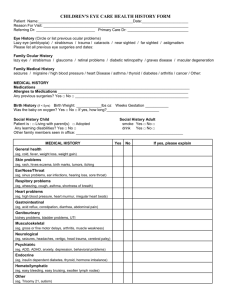
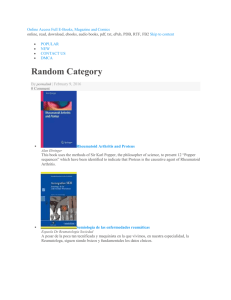



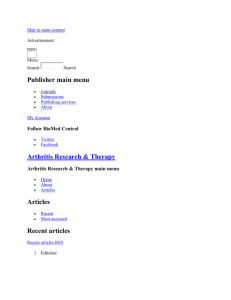
![Drew Smith Lyprinex From Lifeplus is Lyp[...]](http://s3.studylib.net/store/data/006626625_1-79666c56f35487bdcc1f0e10451df3b3-300x300.png)
